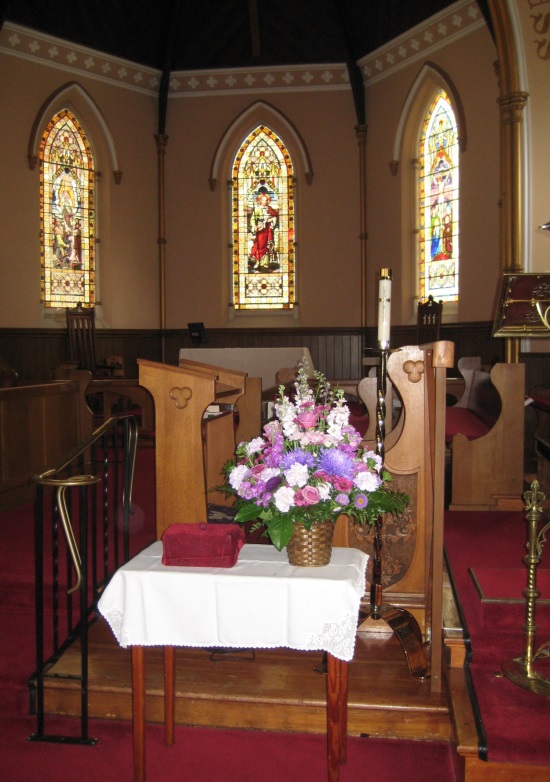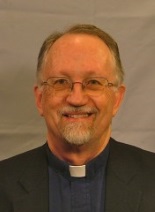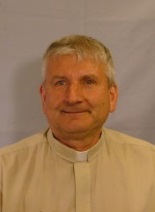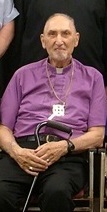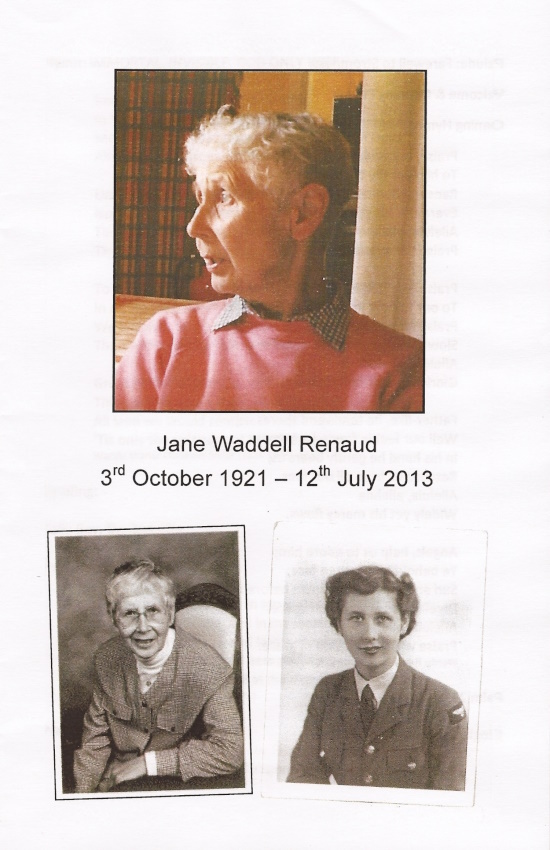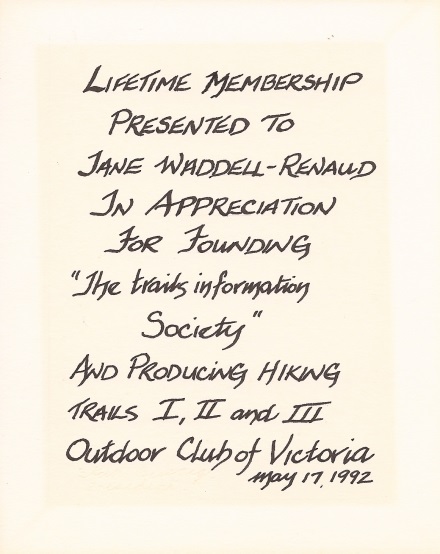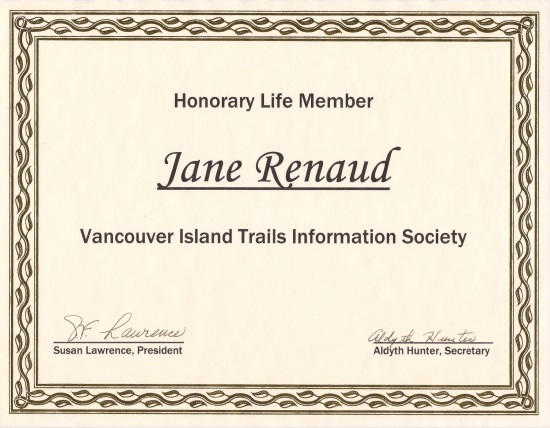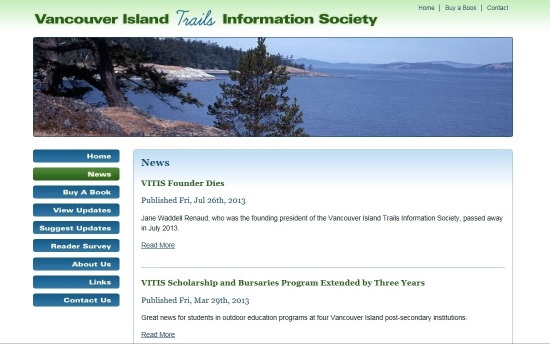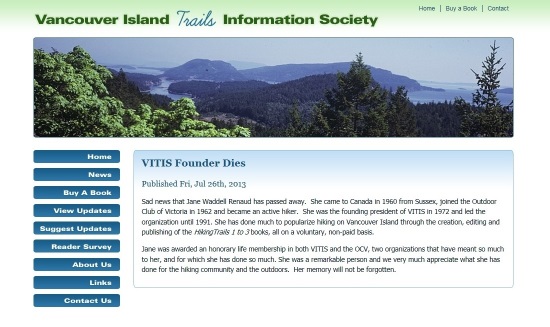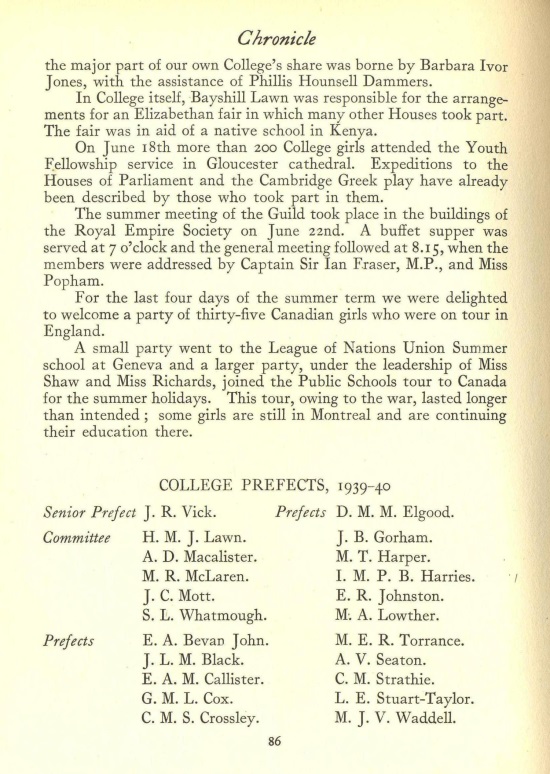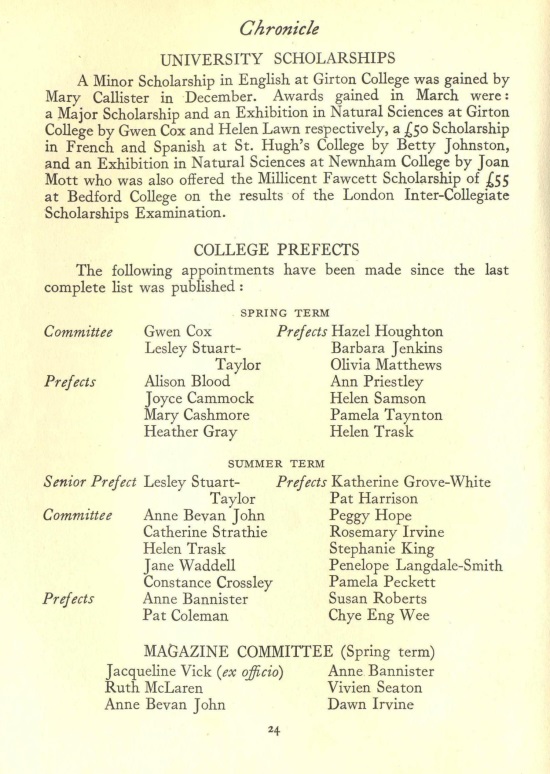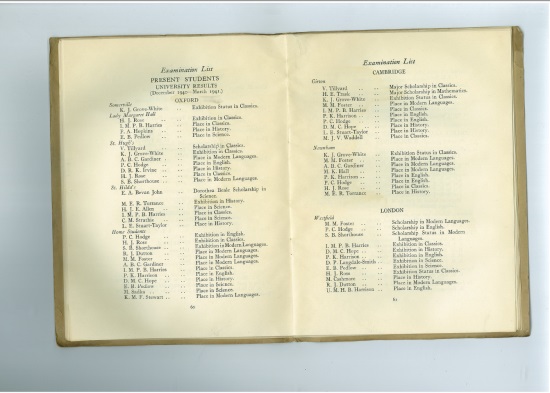Margaret Jane Valentine Renaud née Waddell
(3 Oct 1921 – 12 Jul 2013)
| For reasons that will gradually unfold, a reasonably detailed and self-consistent linear account of Jane's life only really took shape as a result of the spoken tributes paid to her during her recent funeral in Victoria BC. So I shall start her story at the end and work back to the beginning. |
Memorial Service for Jane Waddell Renaud
The Church of Our Lord, Victoria BC
2:00 pm Tuesday 27 August 2013
Attended by
Robin and Sonia Waddell representing the English and Swiss families
James and Claude Waddell representing the Normandy family
Jack Krayenhoff representing Jane's long-established Victoria friends
Marion Edworthy and her son Mark likewise
Eric Burkle representing the Vancouver Island Trails Information Society
Katherine Black representing the Outdoor Club of Victoria
Bill Hawker representing Jane's fellow-residents at Douglas House
Valla representing the staff of Douglas House
and many more, to a total of well over forty people.
Three of the clergy at the Church of Our Lord took part in the service:
(Further details of Rev Dr Rod Ellis, Assistant Pastor Peter Umland, Bishop Rob Badham and all their other pastoral colleagues are given on the About Us tab of the Church of Our Lord website)
A very fine Order or Service had been put together at amazingly short notice by the Admin team, following collective family input at a meeting with Rod just two days previously:
Tributes were paid by
- Robin Waddell (eldest nephew)
- James Waddell (youngest nephew)
- Eric Burkle (fellow hiker and President of VITIS)
- Jack Krayenhoff (longstanding friend at COOL)
And Rob Barham – a lovely man – spoke with great affection of Jane's enthusiastic participation in Church History study, Gaelic classes and the weekly HymnSing at COOL. He spoke of her already detailed knowledge of the Scriptures and the Early Christian Fathers, but this was no surprise to those of us who had read the memoir of her father in the Cridge newsletter.
I found the tributes from the other speakers to be immensely informative, both factually and empathetically, enabling me to integrate my scattered fragments of the Auntly jigsaw puzzle into a more or less complete picture. I hope that this will become apparent during the remainder of the profile.
The service had begun with a rather poignant guitar solo version of Farewell to Stromness, in recognition of the Orcadian ancestry of Jane's family, and it ended with an internet sequence of classical lute music, exquisitely performed by James and Claude's younger son, Simon Waddell. (Inbetweenwhiles, we heard Walford Davies' beautiful setting of the prayer God be in my Head in a recording by the choir of Kings' College, Cambridge, and the charismatic Amazing Grace, played in a recording by the pipes, drums and military band of the Royal Scots Dragoon Guards, accompanied by the COOL organist Dr Sheila Sim and the congregation!)
The most marvellous buffet, commissioned from the nearby Thrifty's by James, then awaited us in the adjacent Church Hall – together with tea, coffee and soft drinks hospitably provided by the Church itself – to refresh and fortify us all, and also to provide further opportunity for James and myself, and our wives, to socialise with so many people in Jane's life who hitherto had simply been email contacts or voices over the international telephone line! A very happy finale to a very memorable occasion.
In conclusion, I'd also like to pay tribute not only to the clergy – Rod, Peter and Rob – who officiated at the service, but also to the Church of Our Lord itself, a beautiful building with a glorious history and a confident future, and to its founder, the remarkable Edward Cridge, and to his wife the equally remarkable Mary Cridge. Perhaps I could draw your attention to them too:
ronsdalepress.com/quiet-reformers/
Quiet Reformers: The Legacy of Early Victoria's Bishop Edward and Mary Cridge, Ian Macdonald and Betty O'Keefe, Ronsdale Press, 2010
"This lively biography of Bishop Edward Cridge and his wife Mary paints a vivid picture of early Victoria as it developed from an isolated Hudson's Bay Company post into the bustling capital of British Columbia. Recruited from England by Governor James Douglas in 1854 to be the Church of England chaplain of Fort Victoria, Edward Cridge became an important figure in the spiritual life of the city as the rector of Christ Church.
The Cridges also became two of Victoria's foremost social reformers, leaving an indelible mark on British Columbia's social institutions. Living through the terrible smallpox and black measles epidemics, the latter taking four of their own children, the inseparable pair worked to create the first hospital, beginning with a few beds in a rented cottage and living to 3 it transformed into the Royal Jubilee. As the first superintendent of education, Cridge played an essential role in B.C.'s early school system. When abandoned children were left at the parsonage door, Mary created Victoria's first orphanage.
The biography also tells of Cridge's very public argument with Bishop Hills, a dispute that caused him to break with the Church of England to found and build the Church of Our Lord, a Reformed Episcopal church, which is today an historic Victoria landmark. Included also are cameos by many of the notable people of the day, such as Emily Carr, who as a young girl lived opposite the Cridge family."
web.uvic.ca/vv/student/orphans/founders.html
This fascinating website focuses on the foundation of the BC Protestant Orphans' Home by Mary Cridge in 1873, but also provides plenty of biographical detail about the Cridges themselves.
This article from The Islander issue of 13 Jul 2010 tells the stirring tale of Edward Cridge's career from his early days as Assistant Master at Oundle (the English public school), his appointment as chaplain to the Hudson's Bay Company in Victoria BC, then Anglican rectorship at Christ Church, followed by the dispute with Bishop Hills over the use of ritual, and eventual consecration as Bishop of the Reformed Episcopal Church, seated at the Church of Our Lord.
Bearing in mind the family history of religious secession (Ebenezer Erskine in the eighteenth century and Peter Hately Waddell Sr in the nineteenth), I think that Jane, also of great integrity and personal independence herself, must have identified closely with the principled origins of the Church of Our Lord and with Edward and Mary Cridge themselves.
Jane's Narratives
In the last few years of her life – after she took up residence at Douglas House – Jane started to open up, as Cousin James put it in his Tribute, and to throw some light into those murky areas of family history, previously off-limits, during which relationships had become frayed or even severed.
All these she passed on to us in three ways – in her letters to the nephews individually, and in formal written memoirs which she (generally) managed to distribute to all three of us, and in late-night telephone calls – she was eight or nine hours behind us on the clock, so her afternoon calls (Victoria time) would come through at midnight or later (UK or European time)! Often enough it was we who called her, but we had to sit up pretty late to catch her in her room.
We shall meet each category of narrative in what follows. And sometimes, of course, her narratives were light-hearted or even rather risqué.
- Memory of a 1928 Summer Holiday (original)
Jane wrote this out, and had it typed up, as an entry to a national short-story competition. It was well-received by the judges, but didn't win any prizes – possibly because it was factual rather than fictional, and possibly because it's really several stories compressed into one. Nonetheless, I love the flavour of a lost way of life where two young sisters could be sent off on a lengthy train journey in the charge of a 13 year old brother – and what a resourceful brother too, as we find out. But I'm fairly sure that Maud was a courtesy Aunt, as there's no sign of a Maud, let alone a Matilda, in the family background. - Memory of a 1928 Summer Holiday (transcript)
- Girdling the Dome of St Paul's Cathedral
For over 80 years it had been part of family lore that Robert Waddell had been the driving force behind the reinforcement of the dome(s) of St Paul's, but not until Jane set down her personal recollections in the Cridge Newsletter did the details of her father's achievement get into the public domain. The Cridge Club itself, mentioned earlier by Dr Jack Krayenhoff, is a social organisation that meets in The Church of Our Lord in Victoria BC, and is named for the founder of that church.
- Uncle Tonal (original)
May Donaldson, aka Uncle Tonal, was Grannie Waddell's oldest & dearest friend, and my father's godmother. She was also a magnificent eccentric, a superb photographer and tireless chronicler of the ancient way of life of the Western Highlands and Islands. Sadly I never managed to elicit further information, but this letter quite possibly tells us all that could be expected at this late date. - Uncle Tonal (transcript)
- The Fergusons of 5 Hampstead Way (original)
After receiving this memoir from Jane, I scanned it and incorporated most of it into the profile of Aunt Meg Ferguson née Waddell. This is the original scan. - The Fergusons of 5 Hampstead Way (transcript) And this is the unredacted transcription, spotlighting the Waddell family dynamics in the inter-war years.
- Frances and Jane (original)
Transcribed by brother Simon from a letter sent by Jane only a couple of months before she died. Simon's comments or queries are highlighted in orange. - Frances and Jane (corrected)
As above, but with dates and timescales corrected in blue. It's particularly interesting to realise that Jane's relocation to Canada wasn't originally seen as permanent, but simply to 'make space' for her sister Frances to recover from distress arising from proposals of marriage by the widowered father of the family she'd been looking after in Rome.
- The Facts of Life
Recalled as best I can from a surprising late-night telephone call from Jane, the questions every parent dreads and then tries to delegate.
- Naming and Shaming
A previously unread note from Jane, recalling some mysteries and embarrassments arising from parental insensitivities as to what they decided to call us.
- YWCA
Recalled from several late-night calls from Jane, a friendship spanning two generations.
- Hiking Trails on Vancouver Island (original)
This talk to her fellow-residents at Douglas House about the events of almost 40 years earlier is quite remarkably detailed for a near-90 year old. And it uncovers Jane's steely determination and negotiating skills in project-managing a publishing venture that three predecessors had failed even to get off the ground. - Hiking Trails on Vancouver Island (transcript)
Hiking Trails
Jane revelled in the magnificent scenery of Vancouver Island, and in 1962, a year or two after arriving in Victoria (and reclaiming her outdoor sleeping bag via the cryptic telegram that Cousin James mentioned in his Tribute at her Memorial Service), she began to take advantage of the tremendous recreational, social and creative opportunities provided by the Great Outdoors.
As Eric Burkle recalled in his own excellent Tribute at that service:
Jane joined the OCV [Outdoor Club of Victoria] in 1962 and became an active hiker … But [her] real calling came when there was a need to do something very new – to create the first book of hiking trails on Vancouver Island …
That Christmas, in 1972, the little book became an instant best-seller – 45 pages – and cost $1.00. This was only the start. Two more volumes were published within a couple of years. Jane served as the editor for all the first books…
"It has gone beyond my dreams. There are so many people to be thanked," [she] said three years ago when she gave a presentation about the books at Douglas House …
The books have gone through 32 editions since 1972 with an estimated more than 100,000 copies sold …
She was the founding president of VITIS [Vancouver Island Trails Information Society] in 1972, set up a non-profit society and led the organisation until 1991 …
Jane was awarded an honorary life membership in both VITIS and the OCV, two organisations that have meant so much to her, and for which she has done so much.
These two awards were amongst her most treasured possessions (the other of course being the picture of her father sitting against the Dome of St Paul's Cathedral):
Following the sage advice of the printer Jane first consulted, the Guide comprises three volumes, roughly doubling from volume 1 to volume 3 in the areas of Vancouver Island that they cover:

And at the time of writing (Oct 2013) this is how they look – a far cry from 1972!
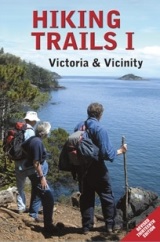


Always on the cutting-edge of publishing technology, the VITIS Guides are now available in e-book format (perhaps not so weather-proof as the older versions?), as announced last year by Eric Burkle.
and it covered the sad news of Jane's death in a very respectful and affectionate way
(Read More …)
This is all very deeply impressive, but let's now step back over forty years and admire that very first Guidebook, that Jane and her dedicated colleagues put together – just in time for Christmas 1972 …
China trip
Apart from her innumerable activities – such as hiking, cycling, sailing, camping, swimming, choral singing, and study of early Christianity – she kept up a vivid and voluminous correspondence with her mother Hannah and sister Frances in her impeccably neat handwriting about all that she had seen and done. The letters to Frances were passed on to me after her death, and it would be a Herculean task to re-read them. But her diary of an organised visit to China in March 1989 (only a few months before the notorious Tiananmen Square massacre on 4 June 1989) is not only well worth reading for its own sake, but is also devoid of any hint of the massive social unrest that was to come. And no sign of photographs either... perhaps cameras had been prohibited, though there’s no mention of this.
The Best and The Rest
The following three letters were particularly recommended by Frances' stepson Dr David Maskell, her executor.
Born in 1921, Jane was almost 40 when she emigrated in 1960, and she reached retirement age by the mid-1980’s – which is when her regular correspondence with Frances seems to have begun in earnest, though of course it’s quite possible that Jane’s letters from before that time simply haven’t survived. Frances was something of a scatterbrain.
Please be aware that, especially in later years, when Jane started to use pre-folded air-letters, a certain amount of remedial surgery has been necessary on my part in each and every case.
The default text-size of virtually all these letters seems to be Extra Large, so please be sure to adjust them accordingly (using the Ctrl Scroll combination).
Note that an item in bold signifies that a substantial change of date has occurred.
Education
The three youngest children – Sandy, Frances and Jane – were quite close in age, and so to start with, according to Jane, they were taught by a governess Miss Bielby, who did her job very well. Whether she was living-in as would a true governess or simply visited every day to tutor the children, is rather immaterial.
They were then sent to a local private school, where, it was hoped, "they would not pick up a Derbyshire accent"! This school was far less effectual that Miss Bielby had been, and so when Jane was seven and Frances eight the two girls were transferred to the Junior section of Chesterfield High School for Girls (despite the risk of acquiring a Derbyshire accent!). Sandy had by this time moved on to Glyngarth preparatory school in Cheltenham, prior to following his elder brother Robin to St George's School, Windsor1, 2, where both were choirboys at St George's Chapel1, 2 in Windsor Castle.
In due course, the girls progressed to the Senior School. The school-leaving age in those days was 14, but children whose parents had the means could continue to the age of 16 and then take the School Certificate exam (English, Maths and three other subjects – all five subjects had to be passed).
Frances wasn't seen as academic and (so I believe) the School Certificate was judged to be inappropriate and she was sent to Domestic Science School in Edinburgh, and did very well indeed. My cousin James tells me that her cooking was superlative!
Jane was viewed as the brainy one, particularly at Latin and Greek – very prestigious accomplishments in those days – and would have been expected to pass School Certificate with ease at the customary age of 16. The question would then have arisen as to whether she should stay at Chesterfield High School for a further two years before taking the Higher School Certificate, or whether she should be transferred to Cheltenham Ladies' College1, 2 for the intensive preparation that could take her even further: the University of Oxford.
There was probably an element of tacit family rivalry involved – Hannah's nieces Lucy and Eleanor Gueritz had both attended Cheltenham Ladies' College, their brothers John and Edward Gueritz had both attended Cheltenham College, and Hannah's brother-in-law Peter had been 'a Balliol man', so I think there must have been a certain amount of pressure on Jane to do well likewise. As she herself put it "[she] was to be the Great Brain ...."
I'm very much indebted to Mrs Rachel Roberts, the Archivist at Cheltenham Ladies' College, for researching on my behalf the actual course of events.
In fact, Jane was only 3 months past her 14th birthday when she was moved on to CLC, assigned to Cambray boarders House. Her arrival was duly recorded in the College Admissions Book:
and she evidently took, and passed, the School Certificate examination in Jul 1938 (with six credits), as recorded in the CLC magazine at that time:
In May 1938 she was elevated to Sub-prefect status, and then in May 1939 to Prefect:
And in May 1940 to Senior Prefect (or at least Committee) status:
though only eight or so of the names on the list above are to be seen in the photograph below, which is more probably of the Form which Jane was in that year:
See if you can spot Jane without looking at the roster below!
(Miss Margaret E Popham was the Principal at that time, and presumably also the mistress of the rather austere little terrier at her feet.)
Jane had also at some stage scooped up (as I understand it) the Philippa Permudan Prize, a prestigious award for the best English Language student (though I can't find any internet clarification of this).
But all was now not well with her. In late Sep 1938 she had been called into the Principal's office to be told that her beloved second brother Robin had died very suddenly and unexpectedly. She was desolated by this and more than seventy years later evidently still felt deeply emotional about the loss of her closest sibling. The effect on her academic focus was evident, as in Jul 1940 she failed her (Oxford & Cambridge) Higher School Certificate exams:
We can all understand and sympathise with this (my own academic progress, such as it was, was always heavily impacted by emotional reverses). But Jane wasn't beaten yet, and stayed on an extra term to resit the exam in Dec 1940 (amidst the national turmoil of constant assault by the Luftwaffe). Though College records of her Higher Certificate results cannot yet be found, what really mattered was the result of her Entrance exam for Girton College1, 2, Cambridge:
And then she left for home – though no longer in Chesterfield, as her father had been bumped from his job as "Steel Works Manager" (see below) and had set up as a metallurgical consultant, in London and the South East.
These were dark days for Britain – the Nazi colossus bestrode Europe, its U-boats ruled the Atlantic, and our national prospects were thoroughly dismal. Whatever her academic ambitions might have been, Jane set them aside for good and all, and at once enlisted into the WAAF1, 2 for the duration of the war. I believe she would have seen this as a vicarious fulfilment of her brother Robin's original schoolboy dream of joining the RAF.



